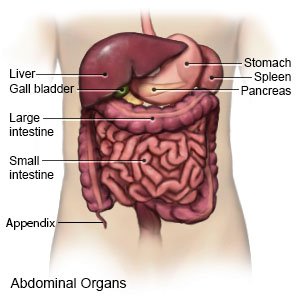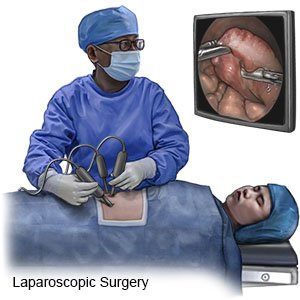Laparoscopic Appendectomy in Children
Medically reviewed by Drugs.com. Last updated on Aug 4, 2025.
What do I need to know about a laparoscopic appendectomy?
Laparoscopic appendectomy is surgery to remove your child's appendix. The surgery is done through small incisions in his or her abdomen.
 |
How do I prepare my child for surgery?
- Tell your surgeon about all allergies your child has. Tell him or her if your child has ever had an allergic reaction to anesthesia or antibiotics. Antibiotics may be given before surgery to prevent an infection caused by bacteria.
- Your child's surgeon will tell you how to prepare your child for surgery. Tell him or her about all medicines, supplements, and vitamins your child currently takes. He or she will tell you if you need to stop giving any of these before surgery, and when to stop.
- You may be told not to let your child eat or drink anything after midnight on the day of surgery. He or she may need to use an enema the night before surgery. An enema will empty his or her bowel. Your surgeon will tell you if your child needs to do this, and how to do it.
Related medications
What will happen during surgery?
- Your child will be given general anesthesia to keep him or her asleep and free from pain during surgery. A catheter may be inserted to drain your child's urine. A nasogastric (NG) tube may be inserted through his or her nose and down into the stomach. This tube keeps air and fluid out of the stomach during surgery.
- A small incision will be made in your child's belly button. The surgeon will insert a laparoscope through the incision. This is a flexible tube with a light and camera on the end. Other instruments will be inserted into 1 to 2 smaller incisions in your child's abdomen. The abdomen will then be inflated with a gas. This lifts the abdominal wall away from the internal organs and allows the surgeon more space to work. Your child's appendix will then be removed.

- Drains (thin rubber tubes) may be placed to remove liquid from the incision area. The incisions will be closed with strips of medical tape.
What should my child expect after surgery?
- Your child may feel pain in his or her shoulder or chest from the gas used during surgery. This is normal and should go away in a day or two.
- Bandages will cover the stitches to keep the area clean and dry to prevent an infection. A healthcare provider may remove the bandages soon after surgery to check the incisions.
- Your child may need to walk around the same day of surgery, or the day after. Movement will help prevent blood clots.
- Medicines may be given to prevent a bacterial infection or to relieve nausea or pain.
- Your child may be on a clear diet at first. He or she may be given ice chips and then liquids such as water, broth, juice, or soft drinks. Healthcare providers will tell you when it is okay for your child to eat his or her regular foods.
What are the risks of a laparoscopic appendectomy?
Your child's stomach, intestines, blood vessels, or nerves may get injured or burned during the surgery. He or she could also have trouble breathing, an infection, or too much bleeding during or after surgery. Your child may get a blood clot in an leg or arm. A clot can break loose and travel to his or her lungs. A blood clot in the lungs can be life-threatening. Problems may happen that cause your child to need an open appendectomy instead. Examples include a burst appendix or an infection or heavy bleeding in his or her abdomen.
Care Agreement
You have the right to help plan your child's care. Learn about your child's health condition and how it may be treated. Discuss treatment options with your child's healthcare providers to decide what care you want for your child. The above information is an educational aid only. It is not intended as medical advice for individual conditions or treatments. Talk to your doctor, nurse or pharmacist before following any medical regimen to see if it is safe and effective for you.© Copyright Merative 2025 Information is for End User's use only and may not be sold, redistributed or otherwise used for commercial purposes.
Further information
Always consult your healthcare provider to ensure the information displayed on this page applies to your personal circumstances.
